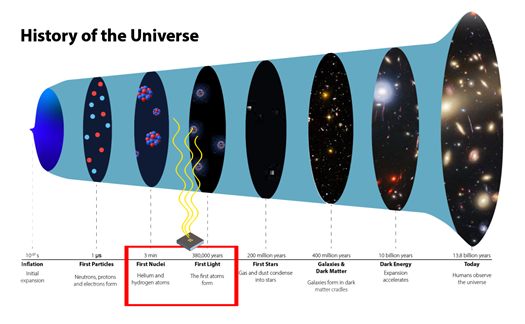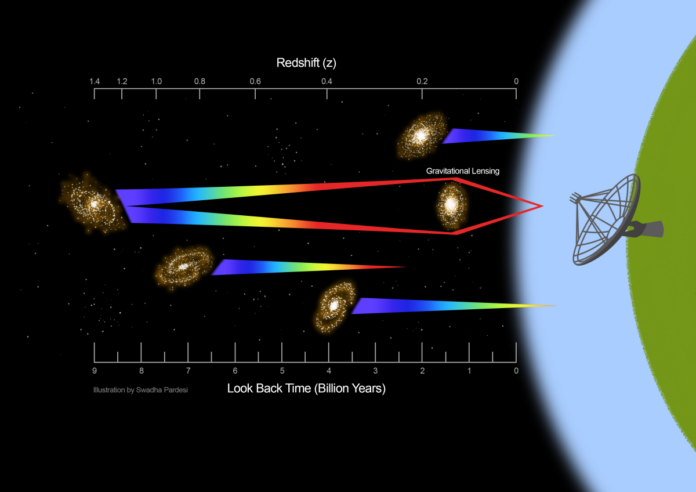In a remarkable step toward unraveling the mysteries of the universe, scientists from the Raman Research Institute (RRI) in Bangalore have developed a novel antenna capable of detecting faint cosmological radio-frequency signals. These signals, known as Cosmological Recombination Radiation (CRR), offer invaluable insights into the thermal and ionization history of the universe during its early stages.
This cutting-edge antenna, operational in the 2.5–4 GHz frequency range, is designed to detect signals nearly a billion times fainter than the widely studied Cosmic Microwave Background (CMB). The development not only marks a significant technological achievement but also represents a pivotal advance in observational cosmology.
What Is Cosmological Recombination Radiation?
The universe, now approximately 13.8 billion years old, began as a hot, dense state immediately following the Big Bang. During its infancy, temperatures were so extreme that atoms couldn’t exist, with matter breaking into fundamental components such as protons, electrons, and light nuclei like helium and lithium.
As the universe expanded and cooled, it transitioned from a fully ionized state into a more stable phase composed of neutral hydrogen and helium atoms. This transformative period, known as the Epoch of Recombination, resulted in the release of photons—a radiation now identified as CRR.
CRR serves as an additive distortion to the CMB, carrying crucial information about the composition and evolution of the early universe. Detecting these elusive signals, which are nine orders of magnitude fainter than the CMB, would revolutionize our understanding of cosmological processes.

A Novel Antenna To Solve A Cosmic Mystery
Led by researchers Keerthipriya Sathish and Mayuri Rao from RRI, in collaboration with Debdeep Sarkar from the Indian Institute of Science (IISc), the team has developed a broadband fantail antenna optimized for CRR detection.
Key features of the antenna include:
- Frequency Range: Operating between 2.5–4 GHz, this range is identified as the most promising for detecting CRR signals.
- Design Innovation: The antenna’s unique dual-polarized, four-arm dipole design ensures consistent sensitivity across its operational bandwidth.
- Compact Build: Weighing just 150 grams, the antenna measures 14 cm x 14 cm, making it portable and easily deployable.
- Material Excellence: Constructed with a copper-etched low-loss dielectric substrate and an aluminum ground plate, the design incorporates a foam layer to house connectors, ensuring structural and operational efficiency.
How The Antenna Detects Ultra-Faint Signals?
The antenna’s fantail design provides a uniform radiation pattern with minimal variations of +/-1% across its frequency range. This allows it to focus on a consistent patch of the sky, effectively distinguishing CRR signals from galactic foreground noise.
With a sensitivity of 30 millikelvin (mK), the antenna can detect minute temperature variations in the sky, making it a powerful tool for cosmological studies.
“We plan to study the reported excess radiation at 3.3 GHz, potentially linked to dark matter annihilation or other exotic physics. The results will inform improvements for even greater sensitivity, aiming for the elusive 1 part per billion,” explained Mayuri Rao, a faculty member at RRI.
Applications And Deployment
The researchers aim to deploy arrays of these antennas in radio-quiet locations, areas free from radio-frequency interference. The planar design is manufactured using techniques akin to Printed Circuit Board (PCB) printing, ensuring high accuracy and consistency when replicating for large arrays.
This scalability will be critical for achieving the sensitivity required to detect CRR, advancing efforts to experimentally measure the abundance of primordial helium—an achievement that would provide a clearer understanding of the universe’s early conditions.

Beyond CRR: Exploring New Frontiers
This antenna design represents just the beginning. By leveraging its innovative structure, the research team is planning further enhancements to improve sensitivity and precision. Such refinements aim to bridge the gap toward the detection of CRR signals and refine the study of unexplained phenomena, including dark matter interactions.
The implications extend beyond cosmology. A better understanding of these faint signals could lead to advancements in fundamental physics, radio astronomy, and the development of new technologies for studying the universe.
A New Window Into The Cosmos
The development of this novel antenna marks a transformative step in humanity’s quest to decode the universe’s most profound mysteries. By targeting the faint CRR signals, researchers are not only uncovering the story of the universe’s infancy but also paving the way for future discoveries in cosmology and astrophysics.
This initiative by Indian researchers highlights the nation’s growing role in advancing space science and demonstrates the power of innovative engineering in solving some of the most complex questions about our existence.

